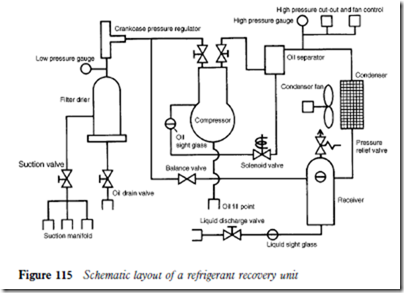Refrigerant recovery system
Figure 115 typifies a portable refrigerant recovery unit now in use within the refrigeration industry.
The compressor is an open reciprocating type, driven by a 1.5 kW single phase drive motor. An oil separator is fitted in the discharge line. Oil return is by float control and a solenoid operated return valve, which is energized by a delay timer.
A conventional finned air cooled condenser has a 75 watt fan motor. A high pressure control is set to cycle the fan at 150 psig (10 bar) cut-in and 120 psig (8 bar) cut-out. The fan control is independent of the compressor control and will continue to run when the compressor stops.
The receiver, capable of holding a relatively large volume of liquid refrig- erant, is fitted with a sight glass. This indicates that the receiver is full when the liquid level is half-way up the glass. A pressure relief valve is also fitted to the receiver and set at 400 psig (26.5 bar). A liquid discharge valve permits drainage of the receiver through a standard hose connection.
A crankcase pressure regulator is installed to manually control the compressor suction to give 9.5 amperes maximum load on the drive motor. A suction valve isolates the suction manifold from the recovery unit. The manifold has three hose unions for multiple connection to various parts of the system from which the refrigerant is to be recovered.
A balance valve connected to both the high and the low sides of the system can be opened to allow:
1 The unit to be operated on a simulated load in order to set the motor load current.
2 The compressor to be started unloaded.
3 Ease of unit evacuation when changing refrigerants.
4 Manual air purging.
Standard glycerine dampened compound and pressure gauges measure the system pressures.
A suction filter drier contains a burn-out core, and acts as a suction boil- off reservoir should small amounts of liquid refrigerant be passed through the unit. It also allows any oil removed from the refrigerant to be drained via a suction filter drain valve with a standard hose connection.
